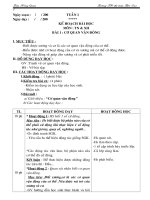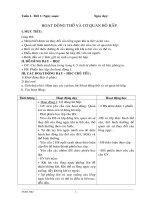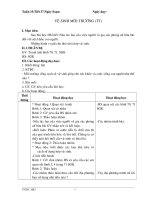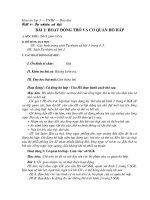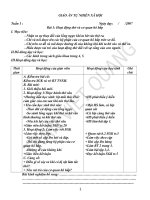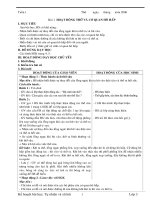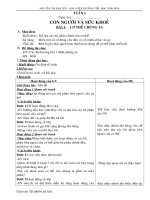chim bồ câu tự nhiên và xã hội 2 bùi thị hiệp thư viện tư liệu giáo dục
Bạn đang xem bản rút gọn của tài liệu. Xem và tải ngay bản đầy đủ của tài liệu tại đây (409.08 KB, 17 trang )
<span class='text_page_counter'>(1)</span><div class='page_container' data-page=1>
<b>ĐÁP ÁN VÀ GIẢI THÍCH ĐỀ THI TUYỂN SINH ĐẠI HỌC KHỐI D NĂM 2008 </b>
<b>Môn thi : ANH – Mã đề 613 (Thời gian làm bài : 90 phút) </b>
<i><b>Ghi chú: </b></i>
- <i>Phần giải thích đáp án được soạn bởi nhóm giảng viên Global Education dựa trên đáp án </i>
<i>cung cấp bởi Bộ GD & ĐT. </i>
- <i>Các phương án được khoanh tròn là đáp án. </i>
<b>ĐỀ THI GỒM 80 CÂU (TỪ CÂU 1 ĐẾN CÂU 80) DÀNH CHO TẤT CẢ THÍ SINH. </b>
<i><b>Ch</b><b>ọ</b><b>n ph</b><b>ươ</b><b>ng án (A ho</b><b>ặ</b><b>c B, C, D) </b><b>ứ</b><b>ng v</b><b>ớ</b><b>i t</b><b>ừ</b><b>/ c</b><b>ụ</b><b>m t</b><b>ừ</b><b> có g</b><b>ạ</b><b>ch chân c</b><b>ầ</b><b>n ph</b><b>ả</b><b>i s</b><b>ử</b><b>a </b><b>để</b><b> các câu tr</b><b>ở</b></i>
<i><b>thành câu </b><b>đ</b><b>úng. </b></i>
<b>Câu 1: Both Mr. and Mrs. Smith are explaining the children the rules of the game. </b>
A B C D
<i>Giải thích: Cấu trúc to explain something to somebody: giải thích cho ai cái gì, vì vậy phương án D </i>
<i>sẽ chuyển thành the rules of the game to the children. </i>
<b>Câu 2: A child of noble birth, his name was famous among the children in that school. </b>
A B C D
<i>Giải thích: sau cụm từ<b> child of noble birth là m</b>ột mệnh đề quan hệ nên his name phải chuyển thành </i>
<i><b>whose name </b></i>
<b>Câu 3: Helen likes to listen to music, to go to the cinema, to chat on the phone and going shopping. </b>
A B C D
<i>Giải thích: Cấu trúc với động từ to like có thểđi với to V hoặc Ving và mang nghĩa là thích làm cái </i>
<i>gì đó, nhưng trong câu trên, 3 cụm từđồng vị với “going shopping” đều là cụm động từ nguyên thể</i>
<i>có to nên going shopping sẽ sửa lại thành to go shopping. </i>
<b>Câu 4: You can enjoy a sport without joining in a club or belonging to a team. </b>
A B C D
<i>Giải thích: To join something = to do together: tham gia, như vậy câu này khơng có giới từ in sau </i>
<i>động từ join. </i>
</div>
<span class='text_page_counter'>(2)</span><div class='page_container' data-page=2>
<i>Key: Chủ ngữ của câu là đại từ she chỉ người nên tương đương với nó, danh từ chính của vế so sánh </i>
<i>đầu câu cũng phải là danh từ chỉ người: writings phải chuyển thành writers. Câu này có thể hiểu là </i>
<i>“Khơng giống như những nhà văn cũng thời, bà không bận tâm đến vấn đềđạo đức”. </i>
<i><b>Ch</b><b>ọ</b><b>n ph</b><b>ươ</b><b>ng án </b><b>đ</b><b>úng (A ho</b><b>ặ</b><b>c B, C, D) </b><b>để</b><b> hoàn thành m</b><b>ỗ</b><b>i câu sau. </b></i>
<b>Câu 6: He’s a very_______ person because he can make other workers follow his advice. </b>
A. influential B. creative C. deciding D. effective
<i>Giải thích: Mệnh đề “he can make other workers follow his advice” có nghĩa là “ơng có thể khiến </i>
<i>những người cơng nhân nghe theo lời khuyên của ông”. Như vậy trong 4 đáp án influential (có tính </i>
<i>thuyết phục), creative (sáng tạo), deciding (có tác dụng quyết định), effective (hiệu quả) thì đáp án </i>
<i><b>influential là phù h</b>ợp về nghĩa nhất. </i>
<b>Câu 7: The referee_______ the coin to decide which team would kick the ball first. </b>
A. cast B. tossed C. threw D. caught
<i>Giải thích: Cụm từ</i> <i><b>to toss a coin: tung </b>đồng xu, cụm từ này thường được sử dụng khi mô tả hành </i>
<i>động của vị trọng tài thực hiện trong một trận đấu để xác định đội nào có bóng trước. </i>
<b>Câu 8: The price of fruit has increased recently, _______ the price of vegetables has gone down. </b>
A. otherwise B. when C. whether D. whereas
<i>Giải thích: Dựa vào hai cụm từ chính ở hai vế của câu “has increased” và “has gone down” có ý </i>
<i>nghĩa đối lập nhau, như vậy liên từ thích hợp trong câu này là whereas. </i>
<b>Câu 9: - Janet: “Do you feel like going to the cinema this evening?” </b>
- Susan: “_______.”
A. You’re welcome B. I feel very bored
C. I don’t agree, I’m afraid D. That would be great
<i>Giải thích: Câu hỏi hàm ý là một câu mời ai đó, và câu trả lời That would be great là phù hợp về</i>
<i>nghĩa nhất. Cụm từ You’re welcome được sử dụng như một câu trả lời lịch sự khi ai đó cảm ơn, đáp </i>
<i>án I don’t agree, I’m afraid sử dụng khi muốn trình bày quan điểm của mình về một vấn đề nào đó, </i>
<i>và cụm từ I feel very bored thể hiện cảm xúc của bản thân. </i>
<b>Câu 10: How long does the play_______? </b>
</div>
<span class='text_page_counter'>(3)</span><div class='page_container' data-page=3>
<i>Giải thích: Trong 4 đáp án : last (kéo dài), stretch (trải dài), extend (mở rộng) và prolong (nối dài, </i>
<i>gia hạn) thì đáp án last mang ý nghĩa về thời gian. Như vậy đáp án chính xác là last, và câu này có </i>
<i>thể dịch là “Vở kịch diễn ra bao lâu?” </i>
<b>Câu 11: The doctor decided to give her a thorough examination_______ he could identify the causes </b>
of her illness.
A. unless B. after C. so that D. so as
<i>Giải thích: Có 2 liên từđược sử dụng trong câu nguyên nhân – kết quả: so that + clause và so as to </i>
<i><b>verb. Nh</b>ư vậy đáp án chính xác của câu là so that. </i>
<b>Câu 12: I’m afraid I’m not really_______ to comment on this matter. </b>
A. quality B. qualifying C. qualified D. qualitative
<i>Giải thích: Từ cần điền trong câu phải là một tính từ hoặc động từ</i> <i>ở dạng tiếp diễn hoặc bịđộng. </i>
<i>Trong 4 đáp án: quality (chất lượng), qualifying (làm cho ai có đủ tư cách), qualified (đủ tư cách), </i>
<i><b>qualitative (</b>định tính), thì đáp án qualified là phù hợp về nghĩa và chính xác về mặt ngữ pháp nhất. </i>
<b>Câu 13: I’m sure you’ll have no_______ the exam. </b>
A. difficulty to pass B. difficulty passing C. difficulties of passing D. difficulties to pass
<i>Giải thích: Cấu trúc To have no difficulty doing something: khơng gặp khó khăn khi làm việc gì đó </i>
<b>Câu 14: I am considering_______ my job. Can you recommend a good company? </b>
A. moving B. to move C. changing D. to change
<i>Giải thích: To consider doing something: cân nhắc vấn đề gì đó </i>
<b>Câu 15: Increasing_______ of fruit in the diet may help to reduce the risk of heart disease. </b>
A. a number B. the number C. the amount D. an amount
<i>Giải thích: Amount được sử dụng để chỉ số lượng của những danh từ khơng đếm được cịn number </i>
<i>được sử dụng để chỉ số lượng những danh từ</i> <i>đếm dược. Câu trên đề cập đến một loại trái cây nói </i>
<i>chung đã được xác định nên đáp án chính xác là the amount. </i>
<b>Câu 16: - Laure: “What a lovely house you have!” </b>
- Maria: “_______.”
</div>
<span class='text_page_counter'>(4)</span><div class='page_container' data-page=4>
C. I think so D. Of course not, it’s not costly
<i>Giải thích: “What a lovely house you have!” - Ngôi nhà của anh thật tuyệt! - là một câu cảm thán </i>
<i>thể hiện lời khen ngợi về ngôi nhà, và “Thank you. Hope you will drop in” – (Cảm ơn anh. Hi vọng </i>
<i>là anh sẽ ghé thăm) là lời đáp lịch sự và phù hợp nhất. A dùng đểđáp lại lời xin lỗi, C dùng đểđồng </i>
<i>ý với ý kiến người khác còn câu từ chối lời khen ở phương án D khơng phù hợp với văn hóa phương </i>
<i>Tây. </i>
<b>Câu 17: That hotel is so expensive. They_______ you sixty pounds for bed and breakfast. </b>
A. charge B. take C. fine D. cost
<i>Giải thích: Cấu trúc to charge somebody (amount of money) for something: tính giá (bao nhiêu) </i>
<i>cho cái gì/ dịch vụ gì đó. </i>
<i>Ví dụ: They charge you $20 to get in the night club. (Họ tính giá 20 đơ la cho việc vào câu lạc bộ</i>
<i>đêm). </i>
<b>Câu 18: It is blowing so hard. We _______ such a terrible storm. </b>
A. had never known B. have never known
C. have never been knowing D. never know
<i>Giải thích: Câu trên đang đề cập một sự kiện mà bạn chưa gặp trước đây bao giờ (never) nên động </i>
<i>từ trong câu được chia ở thì hiện tại hoàn thành. </i>
<b>Câu 19: When the old school friends met, a lot of happy memories_______ back. </b>
A. brought B. had been brought D. had brought D. were brought
<i>Giải thích: Nội dung của câu văn trên đang kể lại một sự kiện đã diễn ra trong quá khứ nên thì của </i>
<i>động từ trong câu phải để</i> <i>ở quá khứđơn. Bên cạnh đó, tân ngữ của câu (a lot of happy memories) </i>
<i>được đặt lên làm chủ ngữ nên động từ phải đểở dạng bịđộng. Như vậy đáp án chính xác của câu là </i>
<i><b>were brought. </b></i>
<b>Câu 20: My computer is not_______ of running this software. </b>
A. able B. compatible C. suitable D. capable
<i>Giải thích: Cấu trúc to be capable of doing something: có khả năng làm gì đó </i>
<b>Câu 21: The curtains have_______ because of the strong sunlight. </b>
</div>
<span class='text_page_counter'>(5)</span><div class='page_container' data-page=5>
<i>Giải thích: Trong 4 đáp án của câu: weakened (trở nên suy yếu), faded (bạc màu), fainted (uể oải, </i>
<i>mờ nhạt), lightened (chiếu sáng, rọi sáng) thì đáp án faded là phù hợp về nghĩa nhất. Câu này có thể</i>
<i>hiểu là “Màn cửa đã bị bạc màu vì nắng gắt”. </i>
<b>Câu 22: Today, household chores have been made much easier by electrical_______. </b>
A. instruments B. applications C. appliances D. utilities
<i>Giải thích: electrical appliances: thiết bịđiện, đồ gia dụng chạy bằng điện </i>
<b>Câu 23: The room needs_______ for the wedding. </b>
A. decorating B. decorate C. be decorated D. to decorate
<i>Giải thích: Cấu trúc need + doing something: việc gì đó cần làm (ý nghĩa bịđộng) </i>
<b>Câu 24: I accidentally_______ Mike when I was crossing a street downtown yesterday. </b>
A. lost touch with B. paid attention to C. caught sight of D. kept an eye on
<i>Giải thích: To lose touch with someone: mất liên lạc với ai đó, to pay attention to: tập trung, chú ý; </i>
<i><b>to catch sight of: g</b>ặp trong chốc lát; to keep an eye on: theo dõi. Như vậy đáp án phù hợp với nghĩa </i>
<i>của câu là caught sight of, câu này được hiểu là “Hơm qua tơi tình cờ gặp Mike khi băng qua đường </i>
<i>ở khu trung tâm buôn bán”. </i>
<b>Câu 25: - “Why wasn’t your boyfriend at the party last night?” </b>
- “He _______ the lecture at Shaw Hall. I know he very much wanted to hear the speaker.”
A. was to attend B. may have attended C. can have attended D. should have attended
<i>Giải thích: Cả 3 đáp án đều B, C, D đều thể hiện dựđoán một sự việc có thể diễn ra trong quá khứ, </i>
<i>trong đó D có nghĩa “đáng lẽ anh ấy nên …”, cịn B và C nghiêng về tình chất dựđốn, nhưng độ</i>
<i>chắc chắn của B cao hơn. Ở vế sau của câu có đề cập I know he very much wanted to hear the </i>
<i><b>speaker nên </b>đáp án của câu là B. </i>
<i><b>Đọ</b><b>c k</b><b>ỹ</b><b>đ</b><b>o</b><b>ạ</b><b>n v</b><b>ă</b><b>n sau và ch</b><b>ọ</b><b>n ph</b><b>ươ</b><b>ng án </b><b>đ</b><b>úng (A ho</b><b>ặ</b><b>c B, C, D) cho m</b><b>ỗ</b><b>i câu t</b><b>ừ</b><b> 26 </b><b>đế</b><b>n 35. </b></i>
The Sun today is a yellow dwarf star. It is fueled by thermonuclear reactions near its center that
convert hydrogen to helium. The Sun has existed in its present state for about four billion six hundred
million years and is thousands of times larger than the Earth.
</div>
<span class='text_page_counter'>(6)</span><div class='page_container' data-page=6>
temperature will fall. The higher temperature of the center will increase the rate of thermonuclear
reactions. The outer regions of the Sun will expand approximately 35 million miles, about the
distance to Mercury, which is the closest planet to the Sun. The Sun will then be a red giant star.
Temperatures on the Earth will become too high for life to exist.
Once the Sun has used up its thermonuclear energy as a red giant, it will begin to shrink. After it
shrinks to the size of the Earth, it will become a white dwarf star. The Sun may throw off huge
amounts of gases in violent eruptions called nova explosions as it changes from a red giant to a white
dwarf.
After billions of years as a white dwarf, the Sun will have used up all its fuel and will have lost its
heat. Such a star is called a black dwarf. After the Sun has become a black dwarf, the Earth will be
dark and cold. If any atmosphere remains there, it will have frozen over the Earth’s surface.
<b>Câu 26: It can be inferred from the passage that the Sun _______. </b>
A. has been in existence for 10 billion years
B. is rapidly changing in size and brightness
C. is approximately halfway through its life as a yellow dwarf
D. will continue to be a yellow dwarf for another 10 billion years
<i>Giải thích: Ởđoạn đầu tiên có câu “The Sun today is a yellow dwarf star… The Sun has existed in its </i>
<i>present state for about four billion six hundred million years”. Như vậy, Mặt trời đã tồn tại được hơn </i>
<i>4 tỉ năm với đặc tính là một ngơi sao lùn màu vàng. Đoạn tiếp theo có câu “About five billion years </i>
<i>from now, the core of the Sun will shrink and become hotter.” Câu này có nghĩa là khoảng 5 tỉ năm </i>
<i>sau, lõi mặt trời sẽ nhỏ lại và trở nên nóng hơn. Như vậy dựa vào các thông tin trên, ta thấy rằng mặt </i>
<i>trời đã trả qua gần 1 nửa thời gian tồn tại là ngôi sao lùn màu vàng. C là đáp án đúng. </i>
<b>Câu 27: What will probably be the first stage of change for the Sun to become a red giant? </b>
A. Its surface will become hotter and shrink. B. It will throw off huge amounts of gases.
C. Its core will cool off and use less fuel. D. Its central part will grow smaller and hotter.
<i>Giải thích: Đoạn 2 có câu “About five billion years from now, the core of the Sun will shrink and </i>
<i>become hotter.” Trong đó, <b>the core chính là central part (ph</b>ần lõi) và shrink nghĩa là to become </i>
<i><b>smaller, or to make something smaller (nh</b>ỏđi). D chính là cách nói tương đương với câu trên và là </i>
<i>đáp án đúng. </i>
</div>
<span class='text_page_counter'>(7)</span><div class='page_container' data-page=7>
B. It will be almost destroyed by nova explosions.
C. It will be enveloped in the expanding surface of the sun.
D. It will become too hot for life to exist.
<i>Giải thích: Cuối đoạn 2 có câu “The Sun will then be a red giant star. Temperatures on the Earth </i>
<i><b>will become too high for life to exist.” Vì v</b>ậy, D là đáp án đúng. </i>
<b>Câu 29: When the Sun has used up its energy as a red giant, it will_______. </b>
A. stop to expand B. cease to exist C. get frozen D. become smaller
<i>Giải thích: Ởđầu đoạn 3 có câu “Once the Sun has used up its thermonuclear energy as a red giant, </i>
<i>it will begin to shrink.” To shrink = to become smaller, or to make something smaller nghĩa là nh<b>ỏ</b></i>
<i><b>đ</b><b>i nên D là </b>đáp án. </i>
<b>Câu 30: Large amounts of gases may be released from the Sun at the end of its life as a _______. </b>
A. yellow dwarf B. black dwarf C. red giant D. white dwarf
<i>Giải thích: “The Sun may throw off huge amounts of gases in violent eruptions called nova </i>
<i>explosions as it changes from a red giant to a white dwarf.” Ta thấy rằng mặt trời thải ra 1 lượng lớn </i>
<i>khí ga khi nó chuyển từ ngơi sao khổng lồ màu đỏ sang sao lùn màu trắng, vì vậy hiện tượng này xuất </i>
<i>hiện ở cuối giai đoạn sao đỏ. C là đáp án đúng. </i>
<b>Câu 31: As a white dwarf, the Sun will be_______. </b>
A. the same size as the planet Mercury B. a cool and habitable planet
C. around 35 million miles in diameter D. thousands of times smaller than it is today
<i>Giải thích: Giữa đoạn 3 có câu “After it shrinks to the size of the Earth, it will become a white dwarf </i>
<i>star.” Mà ta lại có thơng tin ởđoạn đầu như sau “The Sun … is thousands of times larger than the </i>
<i>Earth.” Điều này chứng tỏ khi trở thành ngôi sao lùn màu trắng, Mặt trời sẽ nhỏ hơn hàng ngàn lần </i>
<i>so với hiện tại. </i>
<b>Câu 32: The Sun will become a black dwarf when_______. </b>
A. it has used up all its fuel as a white dwarf B. the core of the Sun becomes hotter
C. the outer regions of the Sun expand D. the Sun moves nearer to the Earth
<i>Giải thích: Đoạn cuối cùng có câu “After billions of years as a white dwarf, the Sun will have used </i>
</div>
<span class='text_page_counter'>(8)</span><div class='page_container' data-page=8>
<b>Câu 33: The word “there” in the last sentence of paragraph 4 refers to_______. </b>
A. the core of a black dwarf B. our own planet
C. the planet Mercury D. the outer surface of the Sun
<i>Giải thích: “After the Sun has become a black dwarf, the Earth will be dark and cold. If any </i>
<i>atmosphere remains there, it will have frozen over the Earth’s surface.” Trong ngữ cảnh này, phó từ</i>
<i><b>there thay th</b>ế cho “the Earth” (Trái Đất) ở câu trước, và đó chính là hành tinh của chúng ta (our </i>
<i>own planet). </i>
<b>Câu 34: This passage is intended to_______. </b>
A. discuss conditions on the Earth in the far future
B. alert people to the dangers posed by the Sun
C. describe the changes that the Sun will go through
D. present a theory about red giant stars
<i>Giải thích: Cấu trúc của bài mơ tả trạng thái hiện tại của Mặt trời, sau đó nêu lên các dựđốn về</i>
<i>các thay đổi của nó trong khoảng thời gian 5 tỉ năm kể từ hiện tại. Theo thứ tự, mặt trời sẽ từ ngôi </i>
<i>sao lùn màu vàng trở thành ngôi sao khổng lồ màu đỏ; rồi thành sao lùn màu trắng và cuối cùng là </i>
<i>sao lùn màu đen. Đây chính là những thay đổi mà Mặt trời sẽ trải qua. </i>
<b>Câu 35: The passage has probably been taken from_______. </b>
A. a scientific chronicle B. a scientific journal
C. a work of science fiction D. a new report.
<i>Giải thích: Bài viết đưa ra các dựđốn khoa học về q trình thay đổi của Mặt trời. Đây không phải </i>
<i>là tác phẩm tiểu thuyết hư cấu, cũng không phải một bản báo cáo mới, cũng không phải là bản ghi </i>
<i>chép những sự kiện khoa học. Đây là một đoạn trong 1 bài báo khoa học. </i>
<i><b>Đọ</b><b>c k</b><b>ỹ</b><b>đ</b><b>o</b><b>ạ</b><b>n v</b><b>ă</b><b>n sau và ch</b><b>ọ</b><b>n ph</b><b>ươ</b><b>ng án </b><b>đ</b><b>úng (A ho</b><b>ặ</b><b>c B, C, D) cho m</b><b>ỗ</b><b>i câu t</b><b>ừ</b><b> 36 </b><b>đế</b><b>n 45. </b></i>
Reading to oneself is a modern activity which was almost unknown to the scholars of the classical
and medieval worlds, while during the fifteenth century the term “reading” undoubtedly meant
reading aloud. Only during the nineteenth century did silent reading become commonplace.
</div>
<span class='text_page_counter'>(9)</span><div class='page_container' data-page=9>
The last century saw a steady gradual increase in literacy and thus in the number of readers. As the
number of readers increased, the number of potential listeners declined and thus there was some
reduction in the need to read aloud. As reading for the benefit of listeners grew less common, so came
the flourishing of reading as a private activity in such public places as libraries, railway carriages and
offices, where reading aloud would cause distraction to other readers.
Towards the end of the century, there was still considerable argument over whether books should
be used for information or treated respectfully and over whether the reading of materials such as
newspapers was in some way mentally weakening. Indeed, this argument remains with us still in
education. However, whatever its virtues, the old shared literacy culture had gone and was replaced
by the printed mass media on the one hand and by books and periodicals for a specialised readership
on the other.
By the end of the twentieth century, students were being recommended to adopt attitudes to books
and to use reading skills which were inappropriate, if not impossible, for the oral reader. The social,
cultural and technological changes in the century had greatly altered what the term “reading” implied.
<b>Câu 36: Reading aloud was more common in the medieval world because_______. </b>
A. there were few places available for private reading
B. people relied on reading for entertainment
C. few people could read to themselves
D. silent reading had not been discovered
<i>Giải thích: Đoạn đầu có câu “Reading to oneself is a modern activity which was almost unknown to </i>
<i>the scholars of the classical and medieval worlds”. Kỹ năng “reading to oneself” hầu như không </i>
<i>được biết đến ở thời Trung cổ nên C là đáp án đúng. </i>
<b>Câu 37: The word “commonplace” in the first paragraph mostly means” _______”. </b>
A. most preferable B. widely used C. for everybody’s use D. attracting attention
<i>Giải thích: Commonplace = happening frequently or often seen or experienced and so not considered </i>
<i>to be special: xảy ra thường xuyên và với phạm vi rộng. Từ này gần nghĩa nhất với cụm từ “widely </i>
<i>used”. </i>
<b>Câu 38: The development of silent reading during the last century indicated_______. </b>
A. an increase in the number of books B. a change in the nature of reading
</div>
<span class='text_page_counter'>(10)</span><div class='page_container' data-page=10>
<i>Giải thích: “Examinations of factors related to the historical development of silent reading have </i>
<i>revealed that it became the usual mode of reading for most adults mainly because the tasks </i>
<i>themselves changed in character.” Ta thấy rằng “silent reading” phát triển là do sự thay đổi trong </i>
<i>bản chất (in character) của việc đọc (the tasks themselves) nên B là đáp án. </i>
<b>Câu 39: Silent reading, especially in public places, flourished mainly because of_______. </b>
A. the decreasing number of listeners B. the decreasing need to read aloud
C. the development of libraries D. the increase in literacy
<i>Giải thích: “The last century saw a steady gradual increase in literacy and thus in the number of </i>
<i>readers. As the number of readers increased, the number of potential listeners declined and thus </i>
<i>there was some reduction in the need to read aloud.” Cảđoạn 2 lý giải việc tại sao “silent reading” </i>
<i>ngày càng phổ biến và nguyên nhân chính cũng là nguyên nhân khởi đầu cho sự phát triển này chính </i>
<i>là “a steady gradual increase in literacy”. </i>
<b>Câu 40: It can be inferred that the emergence of the mass media and specialised reading materials </b>
was an indication of_______.
A. a change in the readers’ interest B. a decline of standards of literacy
C. an improvement of printing techniques D. an alteration in educationalists’ attitudes
<i>Giải thích: “…the old shared literacy culture had gone and was replaced by the printed mass </i>
<i>media…” Dựa vào thơng tin này, ta có thể thấy rằng việc xuất hiện của phương tiện truyền thông và </i>
<i>các loại hình tài liệu chuyên ngành ra đời là do sự thay đổi về văn hóa đọc của độc giả. </i>
<b>Câu 41: The phrase “a specialised readership” in paragraph 4 mostly means “_______”. </b>
A. a limited number of readers in a particular area of knowledge
B. a reading volume for particular professionals
C. a status for readers specialised in mass media
D. a requirement for readers in a particular area of knowledge
<i>Giải thích: Readership chính là số người đọc một tờ báo; specilised là chuyên dụng, dành cho mục </i>
<i>đích riêng. Như vậy cụm từ này được hiểu là số người đọc các tờ báo chuyên dụng, và số lượng này </i>
<i>là có giới hạn. </i>
<b>Câu 42: The phrase “oral reader” in the last paragraph mostly means “a person who_______” </b>
</div>
<span class='text_page_counter'>(11)</span><div class='page_container' data-page=11>
C. takes part in an audition D. is interested in spoken language
<i>Giải thích: Oral (adj): bằng miệng, bằng lời nói. Cụm từ này có nghĩa là diễn thuyết bằng lời nói cho </i>
<i>cơng chúng. </i>
<b>Câu 43: All of the following might be the factors that affected the continuation of the old shared </b>
literacy culture EXCEPT_______.
A. the printed mass media B. the diversity of reading materials
C. the specialised readership D. the inappropriate reading skills
<i>Giải thích: “By the end of the twentieth century, students were being recommended to adopt attitudes </i>
<i>to books and to use reading skills which were inappropriate, if not impossible, for the oral reader.” </i>
<i>Như vậy, các một số kỹ năng đọc dù không phù hợp nhưng vẫn được khuyến khích để duy trì “oral </i>
<i>reader” và cũng chính là “old shared literacy culture”. </i>
<b>Câu 44: Which of the following statements is NOT TRUE according to the passage? </b>
A. Reading aloud was more common in the past than it is today.
B. The change in reading habits was partly due to the social, cultural and technological changes.
C. The decline of reading aloud was wholly due to its distracting effect.
D. Not all printed mass media was appropriate for reading aboud.
<i>Giải thích: C khơng đúng dựa vào bài đọc vì ngồi ảnh hưởng làm người khác bị sao nhãng thì các </i>
<i>yếu tố về văn hóa, xã hội, kỹ thuật v.v… cũng góp phần làm cho hiện tượng “reading aloud” bị giảm </i>
<i>dần và thay thế bởi “silent reading”. </i>
<b>Câu 45: The writer of this passage is attempting to_______. </b>
A. encourage the growth of reading B. explain how reading habits have developed
C. show how reading methods have improved D. change people’s attitudes to reading
<i>Giải thích: Mục đích của bài viết chủ yếu tập trung vào việc giải thích các thói quen đọc của loài </i>
<i>người thay đổi và phát triển từ “reading aloud” đến “silent reading” là như thế nào nên D chính là </i>
<i>đáp án. </i>
<i><b>Ch</b><b>ọ</b><b>n ph</b><b>ươ</b><b>ng án </b><b>đ</b><b>úng (A ho</b><b>ặ</b><b>c B, C, D) </b><b>để</b><b> hoàn thành m</b><b>ỗ</b><b>i câu sau. </b></i>
<b>Câu 46: The robbers attacked the owner of the house_______. </b>
A. but they appeared with the expensive painting
</div>
<span class='text_page_counter'>(12)</span><div class='page_container' data-page=12>
C. so that they would appear with the expensive painting
D. and disappeared with the expensive painting
<i>Giải thích: Đây là tình huống kể lại và liệt kê các hành động liên tiếp xảy ra trong q khứ và có vai </i>
<i>trị bình đẳng nha nên phải chọn D. </i>
<b>Câu 47: _______, he would have learned how to read. </b>
A. Had he been able to go to school as a child B. If he has been able to go school as a child
C. If he could go to school as a child D. Were he able to go to school as a child
<i>Giải thích: Câu trên là cấu trúc câu điều kiện loại 3. “If + S + had done, S + would + have done”. </i>
<i>Trong trường hợp đảo ngữ thì có cấu trúc sau: “Had + S + done, S + would + have done”. Vậy phải </i>
<i>chọn phương án A. </i>
<b>Câu 48: She regretfully told him that_______. </b>
A. she had left the tickets at home B. she left the tickets at home
C. she would leave the tickets at home D. she would have left the tickets at home
<i>Giải thích: Tell somebody that + clause: kể lại cho ai về cái gì. Đây là câu tường thuật gián tiếp nên </i>
<i>động từở vế sau phải lùi một thì so với câu trước. Vậy ta chọn phương án A. </i>
<b>Câu 49: Having been delayed by heavy traffic, _______. </b>
A. it was impossible for her to arrive on time B. her being late was intolerable
C. it was difficult for her to arrive on time D. she was unable to arrive on time
<i>Giải thích: Đây là câu với mệnh đề danh động từ “Having been delayed”. Danh động từ sử dụng </i>
<i>trong trường hợp câu rút gọn khi hai vế có cùng chủ ngữ. Do đó, chủ ngữ của cả hai hành động này </i>
<i>phải là “she”. Câu trên dịch là: Vì bị chậm trễ do tắc đường nên cơ ấy không thểđến đúng giờ. </i>
<b>Câu 50: _______, he was determined to continue to climb up the mountain. </b>
A. Tired as it was B. He felt very tired though
C. Tired as he might feel D. As he might feel tired
<i>Giải thích: Mệnh đề với tính từ “Tired as” đứng ởđầu câu dùng để nhấn mạnh. Cảm giác mệt mỏi là </i>
<i>của chủ ngữ “he” ở phía sau, nên ta phải chọn đáp án C mới chính xác. Câu trên dịch là: Dù rất mệt </i>
<i>mỏi, anh ấy vẫn quyết tâm tiếp tục leo lên ngọn núi đó. </i>
</div>
<span class='text_page_counter'>(13)</span><div class='page_container' data-page=13>
How men first learnt to (51) _______ words is unknown; in other words, the origin of language is a
(52) _______. All we really know is that men, unlike animals, (53) _______ invented certain sounds
to express thoughts and feelings, actions and things so that they could communicate with each other;
and that later they agreed (54) _______ certain signs, called letters, which could be combined to
represent those sounds, and which could be written down. These sounds, (55) _______ spoken or
written in letters, are called words.
Great writers are those who not only have great thoughts but also express these thoughts in words
that (56) _______ powerfully to our minds and emotions. This charming and telling use of words is
what we call literary (57) _______. Above all, the real poet is a master of words. He can (58)
_______ his meaning in words which sing like music, and which by their position and association can
(59) _______ men to tears. We should, therefore, learn to choose our words carefull, (60) _______
they will make our speech silly and vulgar.
<b>Câu 51: </b> A. invent B. make C. create D. discover
<i>Giải thích: invent: tạo ra một cái gì đó mà chưa bao giờ có từ trước. Trong khi đó: discover (khám </i>
<i>phá ra một cái gì đó đang tồn tại), <b>make (t</b>ạo ra mang nghĩa nói chung), create (tạo ra cái gì đó </i>
<i>mang tính sáng tạo; có thể là một ý kiến, tư tưởng, tác phẩm…) </i>
<b>Câu 52: </b> A. legend B. story C. mystery D. secret
<i>Giải thích: unknown = be a mystery: điều bí ẩn, khơng ai biết. Cịn secret (điều bí mật) thì lại có </i>
<i>người biết nhưng không được tiết lộ rộng rãi. </i>
<b>Câu 53: </b> A. whatever B. somewhat C. however D. somehow
<i>Giải thích: Bổ nghĩa cho động từ invented ta phải dùng phó từ somehow (bằng cách nào đó). </i>
<i>Trong khi đó: somewhat + adj/adv: một chút, however + tính t<b>ừ</b><b> + m</b><b>ệ</b><b>nh </b><b>đề</b><b> = whatever + m</b><b>ệ</b><b>nh </b><b>đề</b>: </i>
<i>dù đến đâu, dù như thế nào. Câu trên dịch là: Tất cả những gì chúng ta thực sự biết được là con </i>
<i>người, không giống như</i> <i>động vật, bằng cách nào đó đã sáng tạo ra những âm thanh nhất định để</i>
<i>diễn tả những tâm tư, tình cảm, hành động và sự vật. </i>
<b>Câu 54: </b> A. at B. to C. upon D. with
<i>Giải thích: agree with somebody on/upon something: đồng ý với ai về cái gì </i>
<b>Câu 55: </b> A. whether B. if C. however D. though
</div>
<span class='text_page_counter'>(14)</span><div class='page_container' data-page=14>
<b>Câu 56: </b> A. interest B. appeal C. attract D. lure
<i>Giải thích: appeal to something/somebody: thu hút, cuốn hút đối với cái gì. Cịn các từ khác thì đi </i>
<i>liền với tân ngữ trực tiếp. </i>
<b>Câu 57: </b> A. work B. style C. prose D. form
<i>Giải thích: literary style: văn phong </i>
<b>Câu 58: </b> A. transmit B. convey C. carry D. transfer
<i>Giải thích: convey something: bộc bạch, diễn đạt một ý kiến, một tư tưởng, một ý nghĩ cho người </i>
<i>khác hiểu </i>
<b>Câu 59: </b> A. move B. take C. send D. break
<i>Giải thích: cụm từ “move somebody to tears” có nghĩa là làm cho cảm động chảy nước mắt. </i>
<b>Câu 60: </b> A. or B. although C. so D. because
<i>Giải thích: Trong trường hợp này or = if not: nếu khơng thì (đóng vai trị liên từ) </i>
<i><b>Đọ</b><b>c k</b><b>ỹ</b><b>đọ</b><b>an v</b><b>ă</b><b>n sau và ch</b><b>ọ</b><b>n ph</b><b>ươ</b><b>ng án </b><b>đ</b><b>úng (A ho</b><b>ặ</b><b>c B, C, D) cho m</b><b>ỗ</b><b>i ch</b><b>ỗ</b><b> tr</b><b>ố</b><b>ng t</b><b>ừ</b><b> 61 </b><b>đế</b><b>n 70. </b></i>
The heart has long been considered to be (61) _______ feelings of love dwell. In love songs
throughout the ages, love almost always goes together (62) _______ the heart. The heart has
continuously been viewed (63) _______ the place where love begins and develops. Even the Bible
gives (64) _______ to love and the heart.
The role of the heart in love must come from what happens to it when a person feels strongly (65)
____ to someone. The strong feelings (66) ____ the other person, especially in the early stages of a
relationship, have the results that the heart starts beating faster and breathing starts speeding (67)
____.
According to psychologists, a love relationship is a situation that (68) _______ a lot of stress and
the body reacts to this by getting ready to face the unknown. This has been called the “fight or flight”
(69) ____ meeting danger by fighting it or running away. So with love, the heart accelerates and (70)
_____ becomes quick.
<b>Câu 61: </b> A. that B. when C. where D. what
</div>
<span class='text_page_counter'>(15)</span><div class='page_container' data-page=15>
<b>Câu 62: </b> A. with B. from C. at D. to
<i>Giải thích: Ta có cụm từ go together with something/somebody: đi kèm với </i>
<b>Câu 63: </b> A. as though B. like C. as D. as if
<i>Giải thích: Cấu trúc view something as something: xem như, coi cái gì như cái gì </i>
<b>Câu 64: </b> A. reference B. quote C. preference D. citation
<i>Giải thích: a reference to: ám chỉđến, nhắc đến </i>
<b>Câu 65: </b> A. attracted B. attractive C. attract D. attracting
<i>Giải thích: Sau động từ liên kết (linking verb) feel thì chúng ta phải dùng một tính từ. To be attracted </i>
<i><b>to something: b</b>ị thu hút, quyến rũ bởi cái gì </i>
<b>Câu 66: </b> A. to B. of C. with D. for
<i>Giải thích: feeling for somebody: những xúc cảm dành cho một ai đó </i>
<b>Câu 67: </b> A. on B. forward C. up D. upon
<i>Giải thích: speed up: tăng tốc </i>
<b>Câu 68: </b> A. comprises B. involves C. includes D. arouses
<i>Giải thích: arouse something: đánh thức, khuấy động (tâm tư, tình cảm), <b>include something = </b></i>
<i><b>comprise something: bao g</b>ồm. Trong khi đó involve something: kéo theo, dẫn đến </i>
<b>Câu 69: </b> A. reactionary B. reaction C. reacting D. reactor
<i>Giải thích: Vị trí cần phải điền là một danh từ. Do đó chọn B: reaction. Câu trên dịch là: Đây được </i>
<i>gọi là phản ứng “chiến đấu hoặc bỏ chạy” khi gặp nguy hiểm bằng cách hoặc là chống lại nó hoặc </i>
<i>là rút lui. </i>
<b>Câu 70: </b> A. breathing B. sweating C. exhaling D. inhaling
</div>
<span class='text_page_counter'>(16)</span><div class='page_container' data-page=16>
<i><b>Ch</b><b>ọ</b><b>n ph</b><b>ươ</b><b>ng án </b><b>đ</b><b>úng (A ho</b><b>ặ</b><b>c B, C, D) </b><b>ứ</b><b>ng v</b><b>ớ</b><b>i câu có ngh</b><b>ĩ</b><b>a g</b><b>ầ</b><b>n nh</b><b>ấ</b><b>t v</b><b>ớ</b><b>i m</b><b>ỗ</b><b>i câu cho s</b><b>ẵ</b><b>n sau </b></i>
<i><b>đ</b><b>ây </b></i>
<b>Câu 71: My friend told me, “If I were you, I would not smoke so much.” </b>
A. My friend prohibited me from smoking so much. B. My friend suggested not smoking so much
C. My friend warned me against smoking so much. D. My friend advised me not to smoke so much
<i>Giải thích: Cấu trúc “If I were you, I would do something” là cấu trúc khuyên bảo ai đó. </i>
<b>Câu 72: The sooner we solve this problem, the better it will be for all concerned. </b>
A. It would be better for all concerned if we can solve this problem soon.
B. If all concerned are better, we can solve this problem soon.
C. If we could solve this problem soon, it would be better for all concerned.
D. If we can solve this problem soon, it will be better for all concerned.
<i>Giải thích: Cấu trúc “The sooner…., the better” có nghĩa là: càng sớm càng tốt. Để tương ứng với </i>
<i>thì của câu gốc thì phải chọn câu điều kiện loại 1. Và xét về nghĩa thì chỉ có D là có nghĩa tương </i>
<i>đương. </i>
<i>Câu dịch: Nếu chúng ta có thể giải quyết vấn đề này sớm thì sẽ tốt hơn cho tất cả những người có </i>
<i>liên quan. </i>
<b>Câu 73: “I will let you know the answer by the end of this week,” Tom said to Janet. </b>
A. Tom suggested giving Janet the answer by the end of the week.
B. Tom promised to give Janet the answer by the end of the week.
C. Tom insisted on letting Janet know the answer by the end of the week.
D. Tom offered to give Janet the answer by the end of the week.
<i>Giải thích: Câu trên là một lời hứa (promise) hơn là một gợi ý (suggestion), cầu khẩn (insist), đề</i>
<i>nghị (offer). Câu trên dịch là: Tom nói với Janet rằng: Tơi sẽ cho bạn biết câu trả lời vào cuối tuần </i>
<i>này. </i>
<b>Câu 74: “Why don’t we go out for dinner?” said Mary </b>
A. Mary demanded a diner out. B. Mary suggested a dinner out.
C. Mary ordered a dinner out. D. Mary requested a dinner out.
</div>
<span class='text_page_counter'>(17)</span><div class='page_container' data-page=17>
A. There’s not much more tea left. B. We didn’t have any tea.
C. There’s no tea left. D. We have to run out to buy some tea.
<i>Giải thích: to run out of something: hết sạch </i>
<i><b>Ch</b><b>ọ</b><b>n ph</b><b>ươ</b><b>ng án (A ho</b><b>ặ</b><b>c B, C, D) </b><b>ứ</b><b>ng v</b><b>ớ</b><b>i t</b><b>ừ</b><b> có tr</b><b>ọ</b><b>ng âm chính nh</b><b>ấ</b><b>n vào âm ti</b><b>ế</b><b>t có v</b><b>ị</b><b> trí khác </b></i>
<i><b>v</b><b>ớ</b><b>i ba t</b><b>ừ</b><b> còn l</b><b>ạ</b><b>i trong m</b><b>ỗ</b><b>i câu. </b></i>
<b>Câu 76: </b> A. inventor B. physicist C. president D. property
<i>Giải thích: Cả 3 từ physicist /'fizisist/, president /'prezid</i>әnt/ và property /'pr<sub>ɔ</sub>pәti/ tr<i>ọng âm đều rơi </i>
<i>vào âm tiết thứ nhất, còn inventor /in'vent</i>ә/ tr<i>ọng âm rơi vào âm tiết thứ 2. </i>
<b>Câu 77: </b> A. apply B. reduce C. persuade D. offer
<i>Giải thích: apply </i>/ә'plai/, reduce /ri'dju:s/, persuade /pә'sweid/ <i>đều có trọng âm rơi vào âm tiết thứ</i>
<i>2. offer /'</i><sub>ɔ</sub>fә/ có tr<i>ọng âm rơi vào âm tiết thứ nhất. </i>
<b>Câu 78: </b> A. preferential B. congratulate C. preservative D. development
<i>Giải thích: preferential /,pref</i>ә'ren∫l/ có tr<i>ọng âm rơi vào âm tiết thứ ba, còn trọng âm của 3 từ còn </i>
<i>lại </i>
<i>congratulate/k</i>әn'grætjuleit/, preservative/pri'zә:vәtiv/, development /di'velәpmәnt/ <i>trọng âm rơi vào </i>
<i>âm tiết thứ 2. </i>
<b>Câu 79: </b> A. communicate B. particular C. economy D. unemployment
<i>Giải thích: 3 từ communicate /k</i>ә'mju:nikeit/, particular/pә'tikjulә(r)/, economy/i:'k<sub>ɔ</sub>nәmi/ có tr<i>ọng </i>
<i>âm rơi vào âm tiết thứ 2. Cịn từ</i> unemployment /,<sub>ʌ</sub>nim'pl<sub>ɔ</sub>imәnt/ có tr<i>ọng âm rơi vào âm tiết thứ 3. </i>
<b>Câu 80: </b> A. potential B. recommend C. understand D. volunteer
<i>Giải thích: potential /p</i>ә'ten∫l/ <i>có trọng âm rơi vào âm tiết thứ 2, cịn recommend/,rek</i>ә'mend/;
<i>understand /,</i><sub>ʌ</sub>ndә'stỉnd/ và volunteer /,v<sub>ɔ</sub>lәn'tiә/ tr<i>ọng âm rơi vào âm tiết thứ 3. </i>
</div>
<!--links-->

